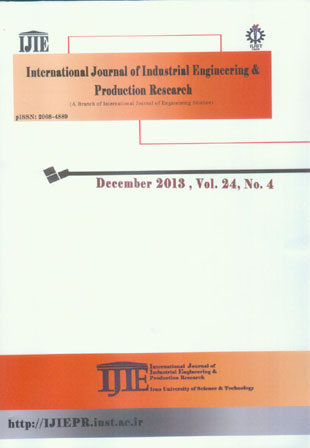فهرست مطالب

International Journal of Industrial Engineering and Productional Research
Volume:24 Issue: 4, Dec 2013
- تاریخ انتشار: 1392/08/02
- تعداد عناوین: 7
-
-
Pages 247-257Today’s world economy situation forces enterprise organizations toward more soft and flexible organization, management, and production processes. They need to explore the most suitable Knowledge Management (KM) tool not only to identify gaps and overlaps but also to maintain and support innovation cross organizations. In this study, a multiple-experts-multiple-criteria decision making model is developed to select the most appropriate set of KM tools to support the innovation processes in organizations. Also, the model aims to suggest conditions for the improvement of KM in different types of knowledge-based inter-organizational collaborations. The application of the model is demonstrated by an illustrative example.Keywords: Knowledge management, Conflict resolution, Process innovation, Fuzzy linguistic aggregation
-
Pages 259-268Increasing competition in the air transport market has intensified active airlines’ efforts to keep their market share by attaching due importance to cost management aimed at reduced final prices. Crew costs are second only to fuel costs on the cost list of airline companies. So, this paper attempts to investigate the cockpit crew pairing problem. The set partitioning problem has been used for modelling the problem at hand and, because it is classified in large scale problems, the column generation approach has been used to solve LP relaxation of the set partitioning model. Our focus will be on solving the column generation sub-problem. For this purpose, two algorithms, named SPRCF and SPRCD, have been developed based on the shortest path with resource constraint algorithms. Their efficiency in solving some problem instances has been tested and the results have been compared with those of an algorithm for crew pairing problem reported in the literature. Results indicate the high efficiency of the proposed algorithms in solving problem instances with up to 632 flight legs in a reasonable time.Keywords: Airline scheduling, crew pairing, set partitioning, column generation, shortest path with resource constraints
-
Pages 277-286We model a real-world case problem as a price competition model between two leader-follower supply chains that each of them consists of one manufacturer and one retailer. T he manufacturer produces partially differentiated products and sells to market through his retailer. The retailer sells the products of manufacturer to market by adding some values to the product and gains margin as a fraction of the all income of selling products. We use a two-stage Stackelberg game model to investigate the dynamics between these supply chains and obtain the optimal prices of products. We explore the effect of varying the level of substitutability coefficient of two products on the profits of the leader and follower supply chains and derive some managerial implications. We find that the follower supply chain has an advantage when the products are highly substitutable. Also, we study the sensitivity analysis of the fraction of requested margin by retailer on the profit of supply chains.Keywords: Supply chain management, Price competition, Pricing, Stackelberg game
-
Pages 285-293Stochastic Approach to Vehicle Routing Problem: Development and Theories Abstract In this article, a chance constrained (CCP) formulation of the Vehicle Routing Problem (VRP) is proposed. The reality is that once we convert some special form of probabilistic constraint into their equivalent deterministic form then a nonlinear constraint generates. Knowing that reliable computer software for large scaled complex nonlinear programming problem with 0-1 type decision variables for stochastic vehicle routing problem (SVRP) is not easily available merely then the value of an approximation technique becomes imperative. In this article, theorems which build a foundation for moving toward the development of an approximate methodology for solving SVRP are stated and proved. Key Words: Vehicle Routing Problem, Chance Constrained Programming, Linear approximation, Optimization.Keywords: Vehicle Routing Problem, Chance Constrained Programming, Linear approximation, Optimization
-
Pages 297-305In this research, the decision on belief (DOB) approach was employed to analyze and classify the states of uni-variate quality control systems. The concept of DOB and its application in decision making problems were introduced, and then a methodology for modeling a statistical quality control problem by DOB approach was discussed. For this iterative approach, the belief for a system being out-of-control was updated by taking new observations on a given quality characteristic. This can be performed by using Bayesian rule and prior beliefs. If the beliefs are more than a specific threshold, then the system will be classified as an out-of-control condition. Finally, a numerical example and simulation study were provided for evaluating the performance of the proposed method.Keywords: Statistical Quality Control, Bayesian Rule, Decision on Belief
-
Pages 307-315In the fundamental production inventory model, in order to solve the economic production quantity (EPQ) we always fix both the demand quantity and the production quantity per day. But, in the real situation, both of them probably will have little disturbances every day. Therefore, we should fuzzify both of them to solve the economic production quantity (q*) per cycle. Using α-cut for defuzzification the total variable cost per unit time is derived. Therefore the problem is reduced to crisp annual costs. The multi-objective model is solved by Global Criteria Method with the help of GRG (Generalized Reduced Gradient) Technique. In this model shortages are permitted and fully backordered. The purpose of this paper is to investigate a computing schema for the EPQ in the fuzzy sense. We find that, after defuzzification, the total cost in fuzzy model is less than in the crisp model. So it permits better use of the EPQ model in the fuzzy sense arising with little disturbances in the production, and demand.Keywords: Economic production quantity, Fuzzy demand, Fuzzy production inventory model, Fuzzy total cost
-
Pages 317-336Customer Lifetime Value (CLV) is known as an important concept in marketing and management of organizations to increase the captured profitability. Total value that a customer produces during his/her lifetime is named customer lifetime value. The generated value can be calculated through different methods. Each method considers different parameters. Due to the industry, firm, business or product, the parameters of CLV may vary. Companies use CLV to segment customers, analyze churn probability, allocate resources or formulate strategies related to each segment. In this article we review most presented models of calculating CLV. The aim of this survey is to gather CLV formulations of past 3 decades, which include Net Present Value (NPV), Markov chain model, probability model, RFM, survival analysis and so on.Keywords: Customer Lifetime Value, Markov chain, RFM method, Survival analysis


